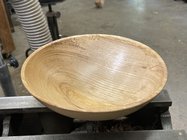What is the best way to seal a 24: log of elm
-
October 2025 Turning Challenge: Natural Edge Bowl! (click here for details) -
Congratulations to Curt Fuller for "Bell Ornaments" being selected as Turning of the Week for October 27, 2025 (click here for details) -
Welcome new registering member. Your username must be your real First and Last name (for example: John Doe). "Screen names" and "handles" are not allowed and your registration will be deleted if you don't use your real name. Also, do not use all caps nor all lower case.
You are using an out of date browser. It may not display this or other websites correctly.
You should upgrade or use an alternative browser.
You should upgrade or use an alternative browser.
wood sealing
- Thread starter Ed Jarvis
- Start date
If you leave it as a full log, it's going to crack on the ends no matter what you do to it. Well short of keeping it in a lake like the old sawmills used to do. Elm doesn't split much anyway. That's why wheel wrights used elm for wagon wheel center hubs.
if the ends have no cracks. Coat them with Anchorseal, white glue, wax or Latex paint. If there are cracks, cut off enough of the ends until the cracks are gone. If the log is not huge you could also put it in a plastic bag
- Joined
- Feb 28, 2021
- Messages
- 1,721
- Likes
- 1,536
- Location
- Roulette, PA
- Website
- www.reallyruralwoodworks.com
My general take on it is to add 1 foot to the diameter of the log (giving 6 inches from either end for checking cut-offs) if my log is that length or longer, I just leave it covered without bothering sealing end grain.. if it is smaller than that I will immediately slice out the pith and then end grain sealer on all bare wood.
So, given a 10 inch diameter log, if it is more than 22" length, I won't bother with it til I want to use it.. then cut off anywhere from 3 to 6 inches to get to unchecked end grain and measure out how much of the log I want to use..
So, given a 10 inch diameter log, if it is more than 22" length, I won't bother with it til I want to use it.. then cut off anywhere from 3 to 6 inches to get to unchecked end grain and measure out how much of the log I want to use..
I keep my logs under tarps, well tarps top and bottom, so pretty much totally sealed that way. If it is going to be a while, then I use wood glue, which is permeable. Had some anchor seal once, and tried it on some madrone, and madrone is one that cracks before you get your chainsaw out of the truck...... Didn't do a very good job. The glue does work better as far as I am concerned.
robo hippy
robo hippy
In order of cost and effectiveness: Anchorseal/wax emulsion, Elmer's Glue, latex paint.
However, in our dry climate, I have to split logs down the pith right away, or everything cracks so badly the log is unusable.
However, in our dry climate, I have to split logs down the pith right away, or everything cracks so badly the log is unusable.
Plastic bags over the ends, and tie tightly. Best is to wrap the entire log with stretch film.
Marc, you don't get spalting doing this? When we lived in Texas if I wrap wood in plastic wrap I would get spalting. Here in Florida if you just look at it you get spalting lol.Plastic bags over the ends, and tie tightly. Best is to wrap the entire log with stretch film.
Leave the log whole, seal ends with glue or plastic bags and stretch wrap, reseal fresh cut end when you cut some for blanks. Sealinng the entire log in plastic I would think would end in a moldy mess, based on short logs I have put in plastic bags for the short term that ended up being longer term (a month or more).
I seal the ends with anchorseal and leave the length until I'm ready to process further. Some inside a covered area and some outside but not in direct sunlight. Keep them off the ground or the side on the ground with decay much faster, insect access, damp and moldy, etc...
I have found that latex paint is absolutely useless. If used on wet wood, it just flakes off from poor adhesion. Used on dry wood, it's generally too late anyway.
A gallon of e l m e r s is $15 at the big box store. I dilute just a bit with water before use. Just enough to make is spreadable with a chip brush, but I try not to make so loose that it slops and runs all over the log. I might wanna include that bark in the piece...
A gallon of e l m e r s is $15 at the big box store. I dilute just a bit with water before use. Just enough to make is spreadable with a chip brush, but I try not to make so loose that it slops and runs all over the log. I might wanna include that bark in the piece...
A technique I heard for using the latex paint, is to slop a bunch of it on, then slap some plastic on the wet paint. This does a good job of sealing the ends.
robo hippy
robo hippy
I haven’t had the problem of rapid spalting. Just to clarify, answer the query more completely, bagging the whole log is short term. My preferred practice is to get the log very fresh, at the time the tree is taken down, usually. First thing, while still on the truck, I pull plastic bags over each log. Then, they are rolled onto the cutting stand and cut into slabs to be cut round later. These are wrapped tightly in a bag, or better, in cling wrap.Marc, you don't get spalting doing this? When we lived in Texas if I wrap wood in plastic wrap I would get spalting. Here in Florida if you just look at it you get spalting lol.
At this point, the shelf life is pretty long.
I wonder if my wrapping near virgin wood, never having sat on the ground, makes a difference regarding spalting.
This is Hickory. I had processed as above, but this and others got left, forgotten, outside in the elements for well over a year. Rain had leaked in. It was black and slimy when I opened it. It’s ok though. I was confident that the wood is in good shape, albeit soaking wet/green. It turned like any greenwood Ive worked. Threw water, soft timber, nice to work. This was once turned and finished with a Danish oil.


